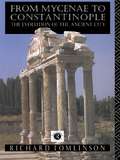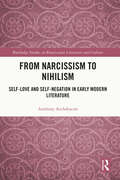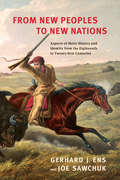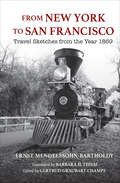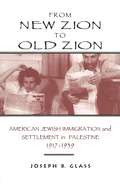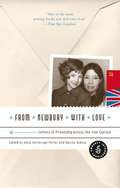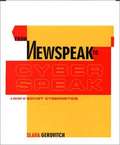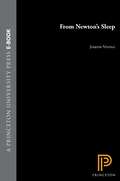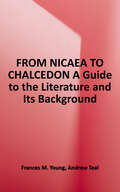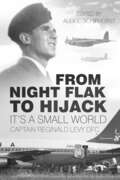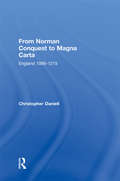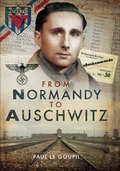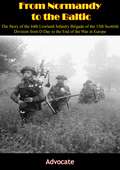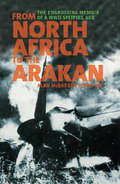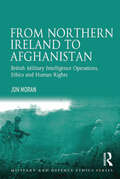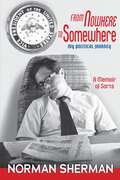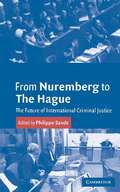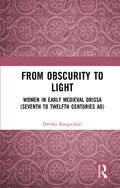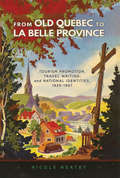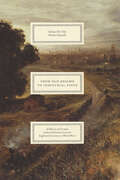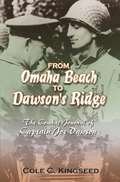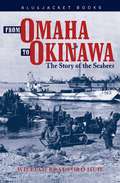- Table View
- List View
From Mycenae to Constantinople: The Evolution of the Ancient City
by Richard A Tomlinson Richard A. TomlinsonTomlinson presents studies of selected ancient cities, ranging from the earliest development of urban architecture in Europe to the imperial cities of Rome and Constantinople. It gives an account of their architecture, not merely from the art historical point of view, but as an expression of the social organisation, and political systems employed by the people who lived in them.
From Narcissism to Nihilism: Self-Love and Self-Negation in Early Modern Literature (Routledge Studies in Renaissance Literature and Culture)
by Anthony ArchdeaconThis book explores how the myth of Narcissus, which is at once about self-love and self-destruction, desire and death, beauty and pain, became an ambivalent symbol of humanistic endeavour, and articulated the conflicts of early modern authorship. In early modern literature, there were expressions of humanistic self-congratulation that sometimes verged on narcissism, and at the same time expressions of self-doubt and anxiety that verged on nihilism. The themes of self-love and self-negation had a long history in western thought, and this book shows how the medieval treatments of the themes developed into something distinctive in the sixteenth century. The two themes, either individually or combined, encompass such topics as poverty, unrequited love, transgressive sexuality, sexual violence, suicidality, self-worth, authorship, religious penitence, martyrdom, courtly ambition and tyranny. Archdeacon uses over 100 texts from the sixteenth and early seventeenth centuries to show how the early modern writer existed in a culture of contrary forces pulling towards either self-affirmation or self-erasure. Writers attempted to negotiate between the polarised extremes of self-love and self-negation, realising that they are fundamental to how we respond to each other, our selves and the world.
From Near and Far: A Transnational History of France (France Overseas: Studies in Empire and Decolonization)
by Tyler StovallFrom Near and Far relates the history of modern France from the French Revolution to the present. Noted historian Tyler Stovall considers how the history of France interacts with both the broader history of the world and the local histories of French communities, examining the impacts of Karl Marx, Ho Chi Minh, Paul Gauguin, and Josephine Baker alongside the rise of haute couture and the contemporary role of hip hop.From Near and Far focuses on the interactions between France and three other parts of the world: Europe, the United States, and the French colonial empire. Taking this transnational approach to the history of modern France, Stovall shows how the theme of universalism, so central to modern French culture, has manifested itself in different ways over the last few centuries. Moreover, it emphasizes the importance of narrative to French history, that historians tell the story of a nation and a people by bringing together a multitude of stories and tales that often go well beyond its boundaries. In telling these stories From Near and Far gives the reader a vision of France both global and local at the same time.
From New Peoples to New Nations
by Gerhard J. Ens Joe SawchukFrom New Peoples to New Nations is a broad historical account of the emergence of the Metis as distinct peoples in North America over the last three hundred years. Examining the cultural, economic, and political strategies through which communities define their boundaries, Gerhard J. Ens and Joe Sawchuk trace the invention and reinvention of Metis identity from the late eighteenth century to the present day. Their work updates, rethinks, and integrates the many disparate aspects of Metis historiography, providing the first comprehensive narrative of Metis identity in more than fifty years.Based on extensive archival materials, interviews, oral histories, ethnographic research, and first-hand working knowledge of Metis political organizations, From New Peoples to New Nations addresses the long and complex history of Metis identity from the Battle of Seven Oaks to today's legal and political debates.
From New York to San Francisco: Travel Sketches from the Year 1869 (Encounters: Explorations in Folklore and Ethnomusicology)
by Ernst Mendelssohn-BartholdyA &“fresh, wonderful, captivating&” journey across 19th-century America through the letters of composer Felix Mendelssohn&’s nephew (alfemminile.blogspot.com). Welcome to an America you&’ve never seen. Where anyone can drop by the White House and visit the President between 10 a.m. and noon; where cowcatchers are bloodied daily on train tracks between New York and Boston; where spent bullets are strewn across Civil War battlefields, and Indians still roam Yosemite Valley; where pigs rut in the sand-and-clay streets of Washington, DC., and the weather-bleached skeletons of oxen and horses line the old mail roads across the West. For three hot summer months in 1869, Ernst Mendelssohn-Barthody, the nephew of famed composer Felix Mendelssohn, traveled by train across the United States accompanied by his older cousin. His letters back home to Prussia offer fascinating glimpses of a young, rapidly growing America. Unceasingly annoyed at the Americans&’ tendency to spit all the time, the Prussian aristocrats seemingly visited everyone and everywhere: meeting President Grant and Brigham Young; touring Niagara Falls, Mammoth Cave, the Redwoods, and Yosemite; taking in New York, Boston, Philadelphia, Chicago, Omaha, San Francisco, and the still war-ravaged city of Richmond; and crossing the continent by rail just two months after the Union Pacific and Central Pacific railroads had been joined at Promontory, Utah. Full of marvelous tales and insightful observations, Ernst Mendelssohn-Barthody&’s letters are a revealing window to a long-ago America. &“If you love epistolary genre and the USA and if you want to understand how Americans lived immediately after the Secession War, From New York to San Francisco is the book you were waiting for.&”—alfemminile.blogspot.com
From New Zion to Old Zion: American Jewish Immigration and Settlement in Palestine, 1917-1939 (American Holy Land Series)
by Joseph B. GlassAmerican Aliyah (immigration to Palestine) began in the mid-nineteenth century fueled by the desire of American Jews to study Torah and by their wish to live and be buried in the Holy Land. His movement of people-men and women-increased between World War I and II, in direct contrast to European Jewry's desire to immigrate to the United States. Why would American Jews want to leave America, and what characterized their resettlement? From New Zion to Old Zion analyzes the migration of American Jews to Palestine between the two world wars and explores the contribution of these settlers to the building of Palestine. <P><P> From New Zion to Old Zion draws upon international archival correspondence, newspapers, maps, photographs, interviews, and fieldwork to provide students and scholars of immigration and settlement processes, the Yishuv (Jewish community in Palestine), and America-Holy Land studies a well-researched portrait of Aliyah.
From Newbury with Love: Letters of Friendship across the Iron Curtain
by Marina Aidova Anna Horsbrugh-PorterConsists of correspondence mainly between the English antiquarian bookseller Harold Edwards and Marina Aidova and her mother, Lera Shestakova.
From Newspeak to Cyberspeak: A History of Soviet Cybernetics
by Slava GerovitchSlava argues that Soviet cybernetics was not just an intellectual trend but a social movement for radical reform in science and society as a whole. Followers of cybernetics viewed computer simulation as a universal method of problem solving
From Newton's Sleep
by Joseph ViningWhat the presence of law tells us about our beliefs, our language, and the world around usIn a strikingly original work intended not only for practicing lawyers but for anyone interested in the modern dilemma of the loss of meaning, Joseph Vining invites us to reconsider law as a unique form of thought, inseparably connected to everything in the world that makes up human identity. Oliver Wendell Holmes asserted at the end of the nineteenth century that human law is ultimately a phenomenon in quantitative relations to its causes and effects, and many have been left with an impression of law as a set of processes and rules. Vining takes issue with this and with various reductionist attempts in scientific thought today to express the universe in a single mathematical description of forces, as well as with post-structuralist speculation that there are no valid truth claims, and that human inter-action can be reduced to analysis of power relationships. Law, he argues, is an independent discourse, not reducible to any other, that exists only in human interaction and reflects continuing human worth. Vining's search to reinstate the spiritual dimension in public discourse brings him head-on with a wide array of powerful academic forces: linguistics theory, political science, the new historicism, and the traditional teaching of law.This book consists of a collection of what Vining calls "amplifications" of the implied text of the law—impressions, commentaries, vignettes, poems, and dialogues—which illustrate aspects of conventional legal language and logic, and the subjects legal practice regularly deals with, such as promises, death, and crime. Throughout we see that law reaches deeply into the way we know ourselves and other persons, all of whom speak through law as law connects language to person and person to action. The texts generated by legal method constitute the living record of social acquaintance and contest, speaking across cultures and across centuries. It is the close reading of legal texts and contexts, Vining argues, that provides the present source of the transcendental in modern secular life. But unlike the other academic arts of interpretation, law alone is directly connected with the most real, the most particular and, at the same time, the most universal facts of social life.From Newton's Sleep casts doubt on the certainties past and present and creates new grounds for skepticism and conviction. The fragmentary form of the book mirrors its subject. It is intended to be picked up and read as occasion allows by lawyers and anyone interested in law.
From Nicaea to Chalcedon: A Guide to the Literature and Its Background
by Frances M. YoungIn this volume, a world-renowned scholar of early Christianity updates and expands her classic survey of the writers and writings of the golden age of Greek patristic theology. This reliable guide to Christian literature from the late third century to the mid-fifth century is more accessible than specialized works on individual authors but more informative than coverage provided by general histories and reference works. The second edition has been revised throughout for use by a new generation of students and scholars and includes a new chapter and updated bibliographies.
From Night Flak to Hijack: It's a Small World
by Reginald Levy Alex SchiphorstThis is the autobiography of Reginald Levy, a British pilot who reached a total of 25,090 flying hours in over 40 years of civil, military, and commercial aviation. He recounts his training and military operations as an RAF pilot during the Second World War. He flies 44 types of aircraft between 1941 and 1981. He takes part in the Berlin Airlift, and in 1952 joins Sabena airline. In 1972, he is hijacked by Black September terrorists, and plays a heroic part thanks to his professionalism and training. Not only does the book offer an insight into the hardships and camaraderie of the war and of the Cold War, it also gives a first-hand report of a Palestinian terrorist attempt. Two of the Israeli commandos who freed the hostages would go on to become Prime Ministers of Israel—Barak and Netenyahu! The epilogue is provided by his youngest grandson.
From Norman Conquest to Magna Carta: England 1066–1215
by Christopher DaniellUsing a combination of original sources and sharp analysis, this book is sheds new light on a crucial period in England’s development. From Norman Conquest to Magna Carta is a wide-ranging history of England from 1066 to 1215 ideal for students and researchers throughout the field of medieval history. Starting with the build-up to the Battle of Hastings and ending with the Magna Carta, Christopher Daniell traces the profound change England underwent over the period, from religion and the life of the court through to arts and architecture. Central discussion topics include: how the Papacy became powerful enough to proclaim Crusades and to challenge kings how new monastic orders revitalized Christianity in England and spread European learning throughout the country how new Norman conquerors built cathedrals, monastries and castles, which changed the English landscape forever how by 1215 the king's administration had become more sophisticated and centralized how the acceptance of the Magna Carta by King John in 1215 would revolutionize the world in centuries to come. This volume will make essential reading for all students and researchers of medieval history.
From Normandy to Auschwitz
by Paul Le GoupilThe odds on Paul le Goupil living to see the end of the Second World War let alone the 21st Century were negligible in 1944. Yet he did.As his extraordinary memoir describes, as a young man he found himself caught up in the maelstrom of the Second World War, active resistance to, and defiance of, the German occupation came naturally to Paul but led to his capture, beating and interrogation by the Gestapo and solitary incarceration in first French prisons. Worse still was to come and after an appalling journey and various labor camps he ended up in Auschwitz and Buchenwald. He experienced starvation, slave labor, unbelievable hardship—death for many was a relief.Paul survived but his suffering was not over as he and others had to endure a nightmare march before being liberated by the advancing Russians. All this and far more make this memoir an unforgettable, moving and inspiring account.
From Normandy to the Baltic: The Story of the 44th Lowland Infantry Brigade of the 15th Scottish Division from D Day to the End of the War in Europe
by AdvocateThis is the story of the 44th Lowland Infantry Brigade of the 15th Scottish Division from D Day until the surrender of the German armies in May 1945.The story is written by one who had the very great honour to be a member of the Brigade HQ staff of the Lowland Brigade throughout the whole period. The writer had also been previously in the Brigade during the greater part of the war, while in the United Kingdom. The story is a catalogue of events as seen and experienced by one man; the indulgence of those who took part in the events described is, therefore, craved for the many inaccuracies which will no doubt be apparent. At the same time, Brigade HQ was probably the best place for getting a bird’s-eye view of operations as a whole, and the account may perhaps be found to be more objective than if the writer had been in one of the battalions. Use has been made of the records of Brigade HQ to check the facts, but not those of the battalions, and the writer has also had the benefit of the help and advice of many officers of the Brigade, to whom his thanks are due.
From North Africa to the Arakan: The Engrossing Memoir of WWII Spitfire Ace
by Alan McGregor PeartAn ace fighter pilot recounts his experiences fighting the Germans and the Japanese from Malta to Burma in this WWII combat memoir. Born in New Zealand in 1922, Alan Peart always dreamed of becoming a Spitfire pilot. During the Second World War, he volunteered for the Royal New Zealand Air Force, and after distinguishing himself in training, joined the elite 610 Squadron. He served in numerous theaters of combat, from Italy and North Africa to India and Burma, where he took part of the Arakan Campaign. Operating from 'Broadway' airstrip, his was the only spitfire not destroyed during air strikes. In this lively account, Peart puts readers in the cockpit as he achieves ace status in heated combat against both German Luftwaffe and the Japanese Army Air Force. He also details the appalling living conditions and the issues the aircrew faced living far from civilization. After miraculously surviving World War II, Peart became president of the Burma Star Veterans association.
From Northern Ireland to Afghanistan: British Military Intelligence Operations, Ethics and Human Rights (Military and Defence Ethics)
by Jon MoranMoran concentrates on three aims: to provide an overview of British military intelligence operations in the last 30 years which concentrates on operational not strategic intelligence; to examine the debates over ethics and effectiveness that have followed these operations; and to examine the increasing attempts to place military intelligence under the same type of regulation that police and security intelligence operations have been subject to. As such, he provides a timely overview of intelligence effectiveness and ethics in this area of heightened interest and relevance in terms of the recent UK deployments to Iraq and Afghanistan, and in the light of the UK Strategic Defence Review. This book is not a philosophical discussion of military ethics; nor is it a study of operations alone. In the light of experiences from Northern Ireland to Afghanistan, it examines the debates over effectiveness which have surrounded British military intelligence activities whilst tying these debates closely to the ethical issues they raise. Each stage of operations is evaluated in context. Interest will cut across disciplines and as such this book will appeal to intelligence, counter-terrorism, military studies, politics, human rights and philosophy practitioners, scholars and students.
From Nowhere to Somewhere: My Political Journey
by Norman ShermanNorman Sherman's idea of fun is attending a political convention. He has been active in progressive politics since before he could vote, often as a ghostwriter and editor of speeches and books. His story describes a life working for numerous political leaders including Minnesota Governor Orville Freeman, and Minnesota senators Wendell Anderson, Walter Mondale, and Hubert Humphrey. He was press secretary to Vice President Humphrey, including during the 1968 campaign. He describes the world of politics with good humor and grace.
From Nuremberg to the Hague: The Future of International Criminal Justice
by Philippe SandsThis fascinating collection of papers examines the evolution of international criminal justice.
From Obscurity to Light: Women in Early Medieval Orissa (Seventh to Twelfth Centuries AD)
by Devika RangachariThis book attempts to reintegrate women into the socio-political milieu of early medieval Orissa. Its sources are inscriptions, mostly Sanskrit, that date from the seventh century to the end of the reign of the Imperial Ganga ruler, Anantavarman Codagangadeva (CE 1078-1147). The evidence indicates that royal and non-royal women had varying but undeniably important roles to play in the socio-political fabric of this prominent regional entity. The Bhauma-Kara dynasty (c. mid-eighth/ninth-late tenth century) that witnessed the rule of six women, four of them in succession, is a case in point. In addition, the palpable presence of several other royal and non-royal women is consistently documented in the epigraphic record. This is an aspect that has received very little attention in secondary works, thereby rendering this study a pioneering one.The work follows on from Rangachari’s earlier Invisible Women, Visible Histories: Gender, Polity and Society in North India (7th to 12th century ad), which had focused on important gendered aspects of early medieval north India through an analysis of literary and epigraphic sources of Kashmir, Kanauj, Bengal and Bihar. The invisibilization of women, whereby their presence is routinely ignored or trivialized, was, similarly, its underlying essence. Please note: This title is co-published with Manohar Publishers, New Delhi. Taylor & Francis does not sell or distribute the Hardback in India, Pakistan, Nepal, Bhutan, Bangladesh and Sri Lanka
From October to Brest-Litovsk
by Leon TrotskyTrotsky's account of the revolutionary events in Russia in 1905. Trotsky's ideas form the basis of Trotskyism, a term coined as early as 1905 by his opponents in order to separate it from Marxism. Trotsky's ideas remain a major school of Marxist thought that is opposed to the theories of Stalinism.
From Oikonomia to Political Economy: Constructing Economic Knowledge from the Renaissance to the Scientific Revolution
by Germano MaifredaRenaissance Europe witnessed a surge of interest in new scientific ideas and theories. Whilst the study of this 'Scientific Revolution' has dramatically shifted our appreciation of many facets of the early-modern world, remarkably little attention has been paid to its influence upon one key area; that of economics. Through an interrogation of the relationship between economic and scientific developments in early-modern Western Europe, this book demonstrates how a new economic epistemology appeared that was to have profound consequences both at the time, and for subsequent generations. Dr Maifreda argues that the new attention shown by astronomers, physicians, aristocrats, men of letters, travellers and merchants for the functioning of economic life and markets, laid the ground for a radically new discourse that envisioned 'economics' as an independent field of scientific knowledge. By researching the historical context surrounding this new field of knowledge, he identifies three key factors that contributed to the cultural construction of economics. Firstly, Italian Humanism and Renaissance, which promoted new subjects, methods and quantitative analysis. Secondly, European overseas expansion, which revealed the existence of economic cultures previously unknown to Europeans. Thirdly factor identified is the fifteenth- and sixteenth-century crisis of traditional epistemologies, which increasingly valued empirical scientific knowledge over long-held beliefs. Based on a wide range of published and archival sources, the book illuminates new economic sensibilities within a range of established and more novel scientific disciplines (including astronomy, physics, ethnography, geology, and chemistry/alchemy). By tracing these developments within the wider social and cultural fields of everyday commercial life, the study offers a fascinating insight into the relationship between economic knowledge and science during the early-modern period.
From Old Quebec to La Belle Province: Tourism Promotion, Travel Writing, and National Identities, 1920-1986 (Studies on the History of Quebec/Études d'histoire du Québec #34)
by Nicole NeatbyTourism promoters strive to brand their destinations in anticipation of what they think travellers hope to experience. In turn, travel writers react in part to destinations in line with their expectations. While several scholars have documented such patterns elsewhere, these have remained understudied in the case of Quebec despite the frequency with which the province was branded and rebranded and its status as a major North American travel destination in the decades leading up to Expo 67. The first comprehensive history of Quebec tourism promotion and travel writing, From Old Quebec to La Belle Province details changing marketing strategies and shows how these efforts consistently mirrored and strengthened French Quebec's evolving national identity. Nicole Neatby also takes into account the contentious role of English-speaking promoters in Montreal, belying the view that Quebec was unvaryingly represented and appreciated for being "old." Taking a comparative approach, Neatby draws on books and a wide array of newspapers, popular and specialized magazines, and written and visual sources from outside the tourist genre to reveal how the distinct national and cultural identities of English Canadians, Americans, and French Quebecers profoundly shaped their expectations and reactions to the province. From Old Quebec to La Belle Province traces and explains shifting promotional priorities for tourism and travel writers' varying reactions over the course of four decades, and how these attitudes harmonized with evolving national identities.
From Old Regime to Industrial State: A History of German Industrialization from the Eighteenth Century to World War I (Markets and Governments in Economic History)
by Richard H. Tilly Michael KopsidisIn From Old Regime to Industrial State, Richard H. Tilly and Michael Kopsidis question established thinking about Germany’s industrialization. While some hold that Germany experienced a sudden breakthrough to industrialization, the authors instead consider a long view, incorporating market demand, agricultural advances, and regional variations in industrial innovativeness, customs, and governance. They begin their assessment earlier than previous studies to show how the 18th-century emergence of international trade and the accumulation of capital by merchants fed commercial expansion and innovation. This book provides the history behind the modern German economic juggernaut.
From Omaha Beach to Dawson's Ridge
by Cole C. KingseedAn infantry company commander in the U.S. Army's heralded 1st Infantry Division, Capt. Joseph Turner Dawson led his men through some of the most brutal battles of World War II. From the invasion of North Africa in late 1942 through Sicily and the assault on Normandy to the push toward the German frontier late in 1944, his length of service on the frontlines was extraordinary, and his heroism while holding off the Germans on a ridge near Aachen, Germany, is legendary. Based on Dawson's own combat journal, this book focuses on leadership in combat during the greatest human drama of the twentieth century. Dawson is at the heart of the drama as he describes the strain of constant combat and its effect on the combat infantryman. His writings have been edited by the former chief military historian at the U.S. Military Academy at West Point, Col. Cole C. Kingseed, who succeeds masterfully in capturing the essence of combat leadership through the actions of this citizen-warrior. Although Dawson was an Army officer, the lessons his journal offer cut across service lines to help readers understand what makes a good frontline commander. The book is published in cooperation with the Association of the U. S. Army.
From Omaha to Okinawa
by William Bradford HuieIn this rousing sequel to his classic Can Do! The Story of the Seabees, William Bradford Huie continues the saga of the combat trained civilian plumbers, carpenters, heavy equipment operators, wharf builders, and civil engineers who served in the U.S. Navy construction battalions. The story begins in 1944 with the battle for Iwo Jima when the Seabees braved concentrated enemy fire and Iwo's daunting terrain to rig floating causeways, blow up wrecked landing craft, and drive their bulldozers up three terraces that rose from the ocean to secure the beachhead. This book fully chronicles their heroism, including the unforgettable efforts of the men of the 31st Battalion who crawled the length of a landing strip to pick up shrapnel as Japanese snipers fired away.Huie does equal justice to the historic actions of the Seabees on D-Day at Omaha Beach, where they manned fifteen hundred vehicles during the first wave of landings at Normandy. He provides fascinating accounts of the creation and testing of various pierheads, floating steel bridges, and "Rhino" ferries. His narrative of Seabee accomplishments is heavily laced with colorful stories of moonshining, brawling, and carousing juxtaposed with compassionate stories of the children in the prisoner of war camps. His enthusiasm for the Seabees gained instant acceptance when this book was first published in 1945 and is often cited as inspiring succeeding generations to rise to the same spirit of devotion and loyalty to their task.
